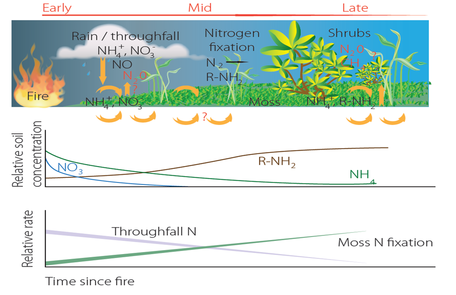Work Package 1
Nitrogen fixation under varied fertility and successional conditions and the liberation of available N
This WP is designed to address key unknowns associated with the impact of ecosystem nitrogen status on N fixation by mosses and the subsequent cycling of this fixed N within the ecosystem.
This WP is designed to address key unknowns associated with the impact of ecosystem nitrogen status on N fixation by mosses and the subsequent cycling of this fixed N within the ecosystem.
Post-fire forest sucession and N fixation

Fig 1 Schematic of forest succession and N cycling in Scots pine forests of boreal Sweden.
Recurrent, low to moderate severity fires in boreal forests consume much of the understory, moss layer, and part of the soil O horizon. Depending on severity, a portion of the total ‘ecosystem N capital’ contained within plant and soil material is lost to combustion. After fire, there is an associated increase in inorganic N availability, with the amount of N in throughfall elevated after fire, then decreasing as succession progresses. Organic N resources lost through combustion during severe wildfire events are eventually recovered through feathermoss-cyanobacterial N-fixation (see Fig. 1). DeLuca et al. 2008 showed that N fixation in feather mosses is suppressed by high throughfall N input, suggesting a feedback mechanism which results in greater N fixation as inorganic N inputs decline (Fig 2).
Feedbacks between N fixation and throughfall N inputs

Figure 2 (A) Relationship between N fixation (measured as
acetylene reduction) and time since fire for the moss bottom layer.
Acetylene
reduction values represent average of 12
subplots at each of 12 sites in northern Sweden that range in age from
39 to 359
years since last fire and averaged across
three sample periods in the summer of 2007. (B) Relationship between throughfall N deposition (resin lysimeter) and time since fire. Throughfall inorganic N (combined NO3–-N and NH4–-N concentrations) averaged across 12 subplots per site and collected from June 2006–June 2007. (C) Relationship between N fixation (15N calibrated acetylene reduction) and throughfall N deposition in northern Sweden. (from DeLuca et. al. 2002)
The impact of anthropogenic N deposition
The evidence from fire chronosequences, and from experimental nitrogen addition studies (Gundale et al. 2011) suggest that N fixation in the feather moss layer is down-regulated under conditions of enhanced nitrogen availability. We extend this work to look at the potential effects of anthropogenic N deposition on boreal N fixation. Under increasing N deposition, do boreal forest mosses retain to the capacity to build N capital?
We also have limited understanding of the fate of N fixed by the cyanobacteria. We expect that much of it is conserved in the moss layer, with most of the fixed N liberated only occasionally during disturbance events such as fire. How is N fixed by feathermoss-cyanobacterial communities cycled and taken up by higher plants?
We also have limited understanding of the fate of N fixed by the cyanobacteria. We expect that much of it is conserved in the moss layer, with most of the fixed N liberated only occasionally during disturbance events such as fire. How is N fixed by feathermoss-cyanobacterial communities cycled and taken up by higher plants?
